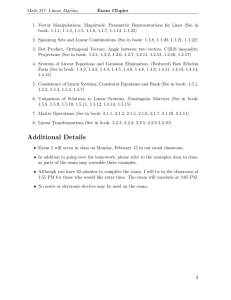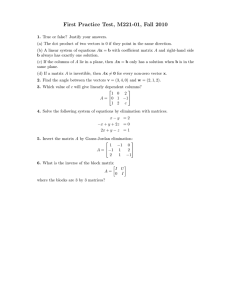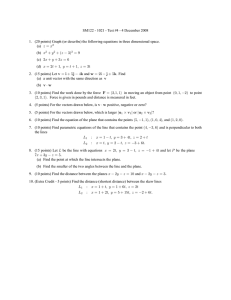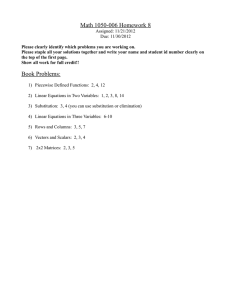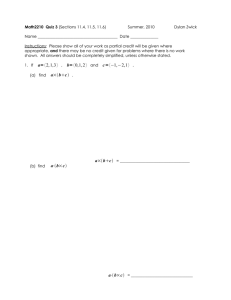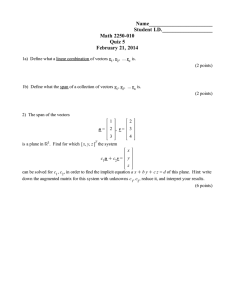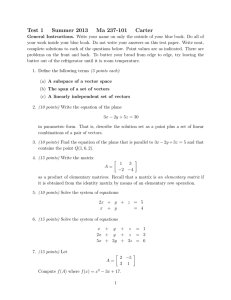Document 13561694
advertisement
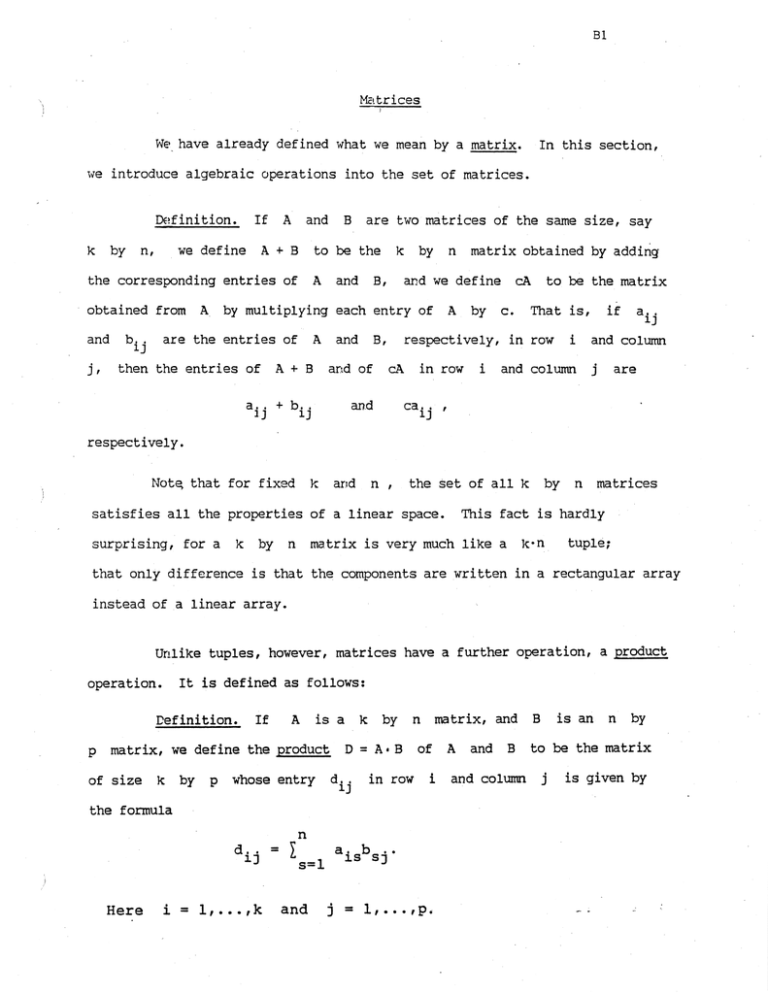
Matrices
We have already defined what we mean by a matrix.
In this section,
we introduce algebraic operations into the set of matrices.
Definition. If A
k by
we define A
n,
t
and B are two matrices of the same size, say
B to be the k by
the corresponding entries of A
n matrix obtained by adding
and B, m d we define cA to be the matrix
obtained from A by multiplying each entry of A by c. That is, if aij
are the entries of A and B, respectively, in row i and column
and bij
j , then the entries of A + B and of cA in row i and column j are
aij
and
bij
caij '
respectively.
PJot? that for fixed
1:
ar:d n
,
the set of all k by n matrices
satisfies all the properties of a linear space. This fact is hardly
surprising, for a k by n matrix is very much like a Ic-n
tuple;
that only difference is that the components are written in a rectangular array
instead of a linear array.
Unlike tuples, however, matrices have a further operation, a product
operation. It is defined as follows:
Cefinition. If
A
is a k by n mtrix, and B
p matrix, we define the product D = A * B of A
of size k by
n
Here
i = k
and B to be the matrix
p whose entry dij in row i and column j
the formula
and
j = I,...,p.
is an n by
is given by
The entry
dij is computed, roughly speaking, by taking the "dot product" of the 1'th
row of A with the j-th
column of
B.
Schematically,
This definition seems rather strange, but it is in fact e,xtremely
useful. Motivation will come later! One important justification for this
definition is the fact that this product operation satisfies some of the familar
"laws of algebra" :
-
Theorem '1. Matrix multiplication has
the following properties: k t
-A, B, C ,-D be matrices.
(1) (Distributivihy)
Similarly; if
.-
If
is defined, then
- A-(B + C) -
-
(B + C). D is defined, then
.-
(El + C)* D = B * D
+
C.D.
(2) (Homogeneity) If
- A*B is defined, then
-
(3) (Associativity) If A * B and B 6 C are
-defined,then
.-
(4) (Existence of identities) Fcr
- each
- m, there
matrix
-
ms ~ c.hthat
-- for
-
I
is an
m by m
matrices A and
- B, we
- have
-
I .A = A
and B *Im = B
li'i
whenever these
products are
--.
- defined.
Proof. We verify the first distributivity formula. In order for
B + C to be defined, B and C must have the same size, say n by p.
m e n in order for A - ( B + C) to be defined, A must have n columns. Suppose
A has size 'x by n.
.Then A - B
and A - C aredefinedand have size k
by p; thus their sum is also defined. The distributivity formula now follows
from the equation
n
n
)=I
1
a (b.+c
s=l is SJ sj
a b
s=l is sj
+I
n
a c
s=l is sj'
The other distributivity formula and the homogeneity formula are proved similarly.
We leave them as exercises.
Now let us verify associativity.
A
B
is
provided
k
C
If
A
by
p.
k
is
by
- .
n
The product
has size p
by
and
B
(AeB)
is
C
n
defined in precisely the same circumstances.
p,
then
is thus defined
The product A
q.
by
( B * C ) is
Proof of equality
I (
is an exercise in summation symbols:
column
j
of
(A*B)
C
The entry in row
is
and the corresponding entry of
A
(B=C)
is
i
and
These t w o expressions are equal.
Finally, we define matrices
that act as identity elements.
I*
Given m, let Im be the m by rn matrix whose general entry is
4j,
where
&
1j
= 1
if
matrix that has
I4
i = j and
6:lj = 0
if i # j. The matrix Im is a square
1's down the "main diagonal" and 0's elsewhere. For instance,
is the matrix
Now the product Im*A
is defined in the case where A has m
this case, the general entry of the product C =
Im - A
is given by the equation
Let i and j be fixed. Then as s ranges from 1 to m,
of the terms of this sunanation vanish.
0+. . . + 0 +
Ti
Qlj
+
O+ . . a +
&.1s =
0=
Ar, entirely similar proof shows that
Remark.
defined.
be equal.
If
A
B
a1.l but one
The only one that does not vanish
is the one for which s = i, and in that case
cij =
rows. In
We conclude that
1.
Q5.
B * Im = B
is defined, then
if B has rn columns.
B
A
need n o t b e
And e v e n i f it i s d e f i n e d , t h e two p r c d u c t s need n o t
For example,
Remark. A natural qestion to ask at this point concerns the existence
of multiplicative inverses in the set of matrices. WE'shall study the answer
to this question in a later section.
Exercises
1.
Verify the other half of distributivity.
2.
Verify homogeneity of matrix multiplication.
3. Show the identity element is unique.
[Hint: If I
and
I;
are two possible choices for the identity element of size m by m, compute
1;
I;
,I
4. Find a non-zero 2 by
2 matrix A
such that A * A is the zero
matrix. Conclude that there is no matrix B such that B O A = 12.
5. Consider the set of m by m matrices; it is closed under addition
and multiplication. Which of the field axioms (the algebraic axioms that the
real numbers satisfy) hold for this set?
in modem algebra a "ring with identity. I ! )
(Such an algebraic object is called
Systems of linear equations
Given numbers
aij
for
i = 1
.
k
and
j = l,--=,n,
and given numbers c,,lc
we wish to study the following, which is called
k ,
a system of k linear equations 9 n unknowns:
...,xn)
A solution of this system is a vector X = (xl,
that satisfies each
equation. The solution set of the system consists of all such vectors; it is
a subset of Vn
.
We wish to determine whether this systemhas a solution, and if so, what
the nature of the general solution is. Note that we are not assuming anything
about the relative size of k and n; they may be equal, or one may be larger
than the other.
Matrix notation is convenient for dealing with this systemof equations.
Let A denote the k by n matrix whose entry in rcw i ar?d column j is
aij
Let X and C denote the matrices
B7
These are matrices with only one column; accordingly, they are called column
matrices
.
The system of equations ( * ) can now be written in matrix form as
A solution of this matrix equation is now, strictly speaking, a column matrix
rather than an n-tuple. However, one has a natural correspondence
between n-tuples and column matrices of size n by
1. It is a one-to-one
correspondence, and even the vector space operations correspond. What this means is
that we can identify Vn with the space of all n by
1 matrices if we wish;
all this amounts to is a change of notation.
Representing elements of Vn
as column matrices is so convenient that
we will adopt it as a convention throughout this section, whenever we wish.
Example 1.
[Here we use
X3r
Consider the system
x, y, z
for convenience.]
for the unknowns instead of
xl, x2,
This system has no solution, since
the sum of the first two equations contradicts the third
equation.
D-ample2. Consider the system
2 x + y + z = l
This system has a solution; in fact, it has mora than one solution. In
solving this sytem, we can ignore the third equation, since it is the sum of the
first two. Then we can assign a value to y arbitrarily, say y = t, and solve
the first two equations for x and z. We obtain the result
The solution set consists of all matrices of the form
Shifting back to tuple notation, we can say that the solution set consists of
all vectors X such that
This expression shows that the solution set is a line in
V3, and in "solvingt1
the system, we have written the equation of this line in parametric form.
Now we tackle the general problem.
We shall prove the following
result:
Sbppose one is given a system of k linear equations in n unknowns.
Then the solution set is either (1) empty, or (2) it consists of a single point,
or (3) it consists of the points of an m-plane in Vn, for some m7O.
In case (11, we say the system is inconsistent, meaning that it has no solution.
*
- -
In case ( 2 ) , the solution is unique.
I
in case ( 3 ) , the system has infinitely
many solutions.
F;C shall apply Gauss-Jordan elimination
to prove these facts. The
crucial result we shall need is stated in the following theorem:
Tlieorem 2,
Consider the system of equations
a k by' n matrix and C is a k by
1 matrix.
A'X = C, where A
is
Let B be the matrix obtained by
applying an elementary row operation to A, arrd let C' be the matrix obtained
by applying the same elementary row operation to C. Then the solution set
of the system B - X = C'
is the same as the solution.setof the system A'X = C.
Proof. Exchanging rows i and j of both matrices has the effect of
of the system. Replacing row i by itself
simply exchanging equations i and j
plus c
times row j has the effect of replacing the ith equation by itself
plus c
times the jth equation. And multiplying rcw i by
d
a non-zero scalar
has the effect of multiplying both sides of the ith equation by d. Thus each
solution of the first system is also a solution of the second system.
Nc~wwe recall that the elementary operations are invertible.
Thus the system A'X = C can be obtained by applying an elementary operation to
both sides of the equation B w X = C1. It follows that every solution of the
second system is a solution of the first system.
Thus the two solution sets are identical.
a
WE*consider first the case of a homogeneous system of equations, that is,
a system whose matrix equation has the form
AGX =
9
.
In this case, the system obviously has at least one solution, namely the trivial
solution X = 0.
Furthermore, we know that the set of solutions is a
linear subspace of Vn
, that is, an m-plane through the origin for some m.
We wish to determine the dimension of this solution space, and to find a basis
for it.
Dflfinition. Let A be a matrix of size k by
n.
Let W be the row
space of A; let r be the dimension of W. Then r equals the number of non-zero
rows in the echelon form of A.
true that r
It follows at once that r
5 n, because W is a subspace of Vn
the rank of A
.
It is also
The number r
is called
(or sometimes the -row rank of A).
Theorem 3. Let A be a matrix of size k by
of A.
k.
n. Let r be the rank
Then the solution space of the system of equations A 0 X = 2 is
a subspace of Vn
of dimension n - r.
Proof. The preceding theorem tells us that we can apply elementary
operations to both the matrices
A and 0 without changing the solution set.
Applying elementary operations tcr 0 leaves it unchanged, of course.
So let us apply elementary operations to A so as to bring A into
reduced echelon form D, and consider the system D - X = Q
.
The number of
non-zero rows of D equals the dimension of the row space of A, which is r.
Now for a zero row of D, the corresponding equation is automatically satisfied, no
matter what X we choose. Orily the first r equations are relevant.
Suppose that the pivots of D appear in columns jl,...,jr ' Let J
denote the set of indices lj
,...,jr\ and let K consist of the remaining indices
...)n,
for which j is in J appears with a
Each unknown x
j
non-zero coefficient in only one of the equations of the system D - X = 0.
from the set {I,.
Therefore, we can Itsolveufor each of these unknowns in terms of the remaining
unknowns xk
, for k in K. Substituting these expressions for x ,
into the n-tuple X = (xl,...,xn ) ,
..., x
jl
we see that the general solution of the
jr
system can be written as a vector of which each component is a linear combination
of the
xk
,
for k in K.
(Of course, if k is in K, then the linear
cathination that appears in the kth component consists merely of the single
term
9! )
-
k!t
us pause to consider an example.
.
EJ-ample3-
Let A
be the 4 by
5 matrix given on p.A20.
The
equation A'X = 0 represents a system of 4 equations in 5 unknowns. Nc~w A
reduces by row operations to the reduced echelon matrix
Here the pivots appear in columns 1,2 and 4; thus J
K
is the set f3.53
.
.
The unknowns xl x2, and x4
is the set 11,2.4]
and
each appear in only
one equation of the system. We solve for theese unknowns in terms of the others
as follows:
X1
X*
x,
= 8x3 + 3x5
= -4x3 2x5
=
0.
The general solution can thus be written (using tuple notation for convenience)
The solution space is thus spanned by two vectors
-
(8,-4.1,O.O)
and (3,-2,0.0,1).
The same procedure we followed in this example can be followed in
general. Once we write X as a vector of which each component is alinear combination
of the xk
,
then we can write it as a sum of vectors each of which involves
only one of the unknowns
coefficients
5,
and then finally as a linear combination, with
%I of vectors in Vn
.
There are of course n - r of the
,
unknowns
and hence
n - r of these vectok.
It follows that the solution space of the system has a spanning set
consisting of n - r vectors. We now show that these v~ctorsare independent;
then the theorem is proved.. To verify independence, it suffices to shox? that if xe
take the vector X, which equals a linear combination with coefficents
of these vectors, then X = 0 if and only if each
equals 0.
%
% (for k in K)
This is easy. Consider the first expression for X tkat we wrote down,
where each component of X is a linear combination of the unknowns
The kth component of X is simply
5.
rc-
It follows that the equation X = 2
implies in particular that for each k in K, we have
%
= 0.
For example, in the example we just considered, we see that the equation
X =0 implies that x3 = 0 and x = 0 , because x.. is the third component
5
3
of X and x5 is the fifth component of X.
This proof is especially interesting because it not only gives us the
dimension of the solution space of the system, but it also gives us a method
for finding a basis for this solution space, in practice. All that is involved is
Gauss-Jordan elimination.
Corollary&
Let A be a k by n matrix.
If the rows of A are
0 has dimension n - k.
independent, then the solution space of the system A-X = -
Now we consider the case of a general system of linear equations, of the
form A'X = C
.
For the moment, we assume that the system has at least one
solution, and we determine what the general solution looks like in this case.
Theorem 5. Let A be a k by n matrix.
Let r equal the rank of A.
If the system A*X = C has a solution, then the solution set is a plane in
Vn of dimension m = n - r.
a
Proof. Let X
If X is a
=
P be a solution of the system. Then A-P = C
.
column matrix such that A'X = C, then A.(X - ? ) = 2 , and
ccnversely. The solution space of the system A'X = 0 is a subspace of n'
of dimension m = n - r; let All...,A be a basis for it. Then X is a solution
m
of the system A'X = C if and only if X - P is a linear combination of the
vectors Air that is, if and only if
X = P + t1A1
t...
+
tmAm
for some scalars ti. Thus the solution set is an m-plane in Vn
a
Nciw let us try to determine when the system A'X = C has a solution.
One has the
follow in^ general
Theorem
result:
6. k t A be a
k by
n matrix. Let r equal the rank
of A'
(a) If r 4 k , then there exist vectors C in Vlc
such that the
system A'X = C has no solution.
(b) If r = k, tl~enthe system A-X = C al~~ays
has a solution.
Proof.
We consider the system A'X = C and apply elementary row
operations to both A . and C until we have brought A
into echelon form
.
(For the moment, we need not yo all the hay to reduced echelon form.)
C'
be the column matrix obtained by applying these same row operations to C.
Let
Consider the system B'X = C r .
Consider first the case r < k.
3
In this case, the last row at least of
is zero. The equation corresponding to this row has the form
where c'
is the entry of C 1 in row k. If c'
is not zero, there are no
k
k
values of xl,
xn satisfying this equation, so the system has no solution.
...,
#
Let us choose C * to be a k by
1 mstrix whose last entry is non-zero.
Then apply the same elementary operations as before, in reverse order, to
both B and C*. These operations transform B back to A; when we apply them
to C * , the result is a matrix C such that the system A'X = C has no
solution.
Now in the case r = k,
the echelon matrix B has no zero rows, so
the difficulty that occurred in the preceding paragraph does not arise. We shall
show that in this case the system has a solution.
More generally, we shall consider the following two cases at the same
time: Either ( 1) B has no zero rows, or (2) whenever the ithrow of B is zero,
then the corresponding entry ci* of C' is zero. We show that in either of
these cases, the system has a solution.
Let
US
consider the system B - X = C 1 ard apply further operations to
both B and C', so as to reduce B to reduced echelon form D. Let C"
be the matrix obtained by applying these same operations to C'. Note that the
zero rows of B, and the corresponding entries of C', are not affected by these
operations, since reducing B to reduced echelon form requires us to work only
with the non-zero rows.
Consider the resulting system of equations D'X = C t t . We now proceed as
in the proof of Theorem 3. Let J be the set of column indices in which the
pivots of D appear, and let K be the remaining indices. Since each xi
,
2
for j in J, appears in only one equation of the system, we can solve for each
x
.
in terms of the numbers c; a d the unknowns
We can now assign
j
values arbitrarily to the \ and thus obtain a particular solution of the
system. The theorem follows.
The procedure just described actually does much more than was necessary
to prove the theorem.
It tells us how to determine, in a particular case, whether
or not there is a solution; and it tells us,when there is one,how to express the
solution set in parametric form as an m-plane in
-
n'
.
Ccnsider the following example:
E2:ample 4. Consider once again the reduced echelon matrix of Example 3:
The system
has no solution because the last equation of the system is
On the other hand, the system
does have,a solution. Fc~llowingthe procedure described in the preceding proof,
we solve for the unknowns xl, x2, and x4
as follows:
The general solution is thus the 2-plane in V5
specified by the parametric equation
Remark. Solving the system A-X = C in practice involves applying
elementary operations to A
, and applying these same operations to
C.
A convenient way to perform these calculations is to form a new matrix from
A by adjoining C as an additional column. This matrix is often called the
auqmented matrix of the system. Then one applies the elementary operations to this
matrix, thus dealing with both A and C at the same time.
This procedure
is described in 16.18 of vol. I of Apostol.
Exercises
1.
Let A be a k by n matrix.
(a) If k < n, show that the system
A'X = 0 has a solution different from G.(Is this result familiar?) What
can you say about the dimension of the solution space?
(b) If k > n, show that
therearevalues of C such that the system A'X = C has no solution.
2, Ccnsider the matrix A of p. A23.
of the system AbX = 2.
(a) Find the general solution
(b) Does the system A - X = C have a solution for
arbitrary C?
3.
Repeat Exercise 2 for the matrices C, D l and E of p. A23.
4. &t
B be the matrix of p. A23.
(a) Find the general solution of
.-.113.
the system
=
(b) Find conditions on a,b, and c
that are necessary and sufficient for the
system B - X = C to have a solution, where
C =
.
[~int:What happens to
C when you reduce B to echelon form?]
5. Let A be the matrix of p. A20. Find conditions on a,b,c, and d
that are necessary and sufficient for the system A'X = C to have a :solution,
where
/---
\
@ k t A be a
by n matri::; let r be the rank of :
A
Let R be the set of all those vectors C of Vk fc,rwhich the system
has a solution. (That is, R
is the set of all vectors of the form
X ranges over Vn . )
( a ) Show that R is a subspace of
vk
(b) Show that R has dimension r. [Hint: Let W be the solution
Then W has dimension m = n - r. C oose
space of the system A-X = 9
a basis A f Am for W. By adjoining vectors one at a time, extend
A-X
, as
.
.
Show the vectors
this to a basis Al,...,Am ,B1,...,Br for all of Vn
A.B1 ,
A.3r span R; this follows from the fact that A.Ai = 0 for
all i. Show these vectors are independent.]
(c) Cclnclude that if r € k, there are vectors C in Vk such
that the system A - X = C has no solution; while if r = kt this system
has a solution for all C. (This provides an.alternate proof of Theorem 6.)
...,
@
Let A be a k by n tnztrix. The columns of A, when looked
at as elements of Vk , span a subspace of Vk that is called the column
The row space and column space of A are very different,
space of A
have the same dimension ! Prove
but it is a totally unexpected fact that they --this fact as follows: Let R be the subspace of Vk defined in Exercise
6. Show that R is spanned by the vectors A-Ei,...,A-En ; conclude
that R equals the column space of A.
.
Csrtesian equations
of !:-planes in
n'
'
There are two standard ways of specifying a k-plane
in Vn.
M
One is by an equation in parametric form:
X = 2 + t l A L, + . . . +
vI.ere A , . . . ,
t?<q.l;,
ar2 in3ependent vectors in n'
.
(If tkess vectors xere
not independent, this equation would still specify an n-plane for some m,
5ut some work would be required to determine m. We normally require the
vectors to b2 independent 51 the parametric form of the equation of a ?<-plane.)
bother way to specify a plane in
is as the solution set of a
Vn
system of linear equations
where the rows of A are independent. I f
A
has size k by
n, then
the plane in question has dimension n - k. The equation is called a
caretesian form for the equation of a plane.
(If the rows of A were not
independent, then the solutionsetwould be either empty
, or
an m-plane
for some m, but some work would be required to determine m.)
The- process of "solving" the system of equations A S X = C
that
we described in the preceding section is an algorithm for passing from a
cartesian equation for M to a parametric equation for M.
0r.e can ask
whether there is a process for the reverse, for passing from a parametric
equation for M to a cartesian equation. Tk~eanswer is "yes," as we
shall see shortly. The other question one might ask is, ''Ifnyshould one
care?" The answer is that sometimes one form is convenient, and other times
the other form is more useful. Particularly is this true in the case of
3-dimensional space V3
, as we shall see.
Dflfinition. Let A be a matrix of size k by n.
Let
let W be the subspace of Vn they span. Now the vector
be the rows of A;
X is a solution of the system A e X = g if and only if X is orthogonal
to each of the vectors
.
Ai
This statement is equivalent to the statement
is orthogonal to every vector belonging to W. The solution s2ace
that X
of this' system is for this reason sometimes called the orthoqonal complement of W.
It is often denoted 'W
(read "W perp".)
We have the following result:
Theorem 1
, If W is a subspace of Vn of dimension k, then
its orthogonal complement has dimension n - k.
Fwthermore, W
is the
orthogonal complement of W I ; that is, (WL ) I = W.
wL
Proof. Ttiat
Theorem 3 j
Ai
has dimension n
-k
is an imnediate consequence of
for W is the row space of a k by n matrix A with independent rows
, whence w L
is the solution space of the system A - X =
has dimension n - (n - k)
The space (WL)'
And it contdns each vector Ai
, by what we just proved.
(since Ai *X = 0 for each X in W I.)
Therefore it equals the space spanned by
Theorem
0.
Suppose a k-plane M
,
in Vn
a
is specified by the parametric
equation
X
where the vectors Ai
and let B ,
B1,".,B m '
.
=
P + tA
1 1
+
...
-I- tkq;
I
are independent. Let W be the space they span;
Elrn be a basis for W L . If B
then the equation
is a cartesian equation for M.
is the matrix with rows
B*(x-P) = 0 ,
Or
BiO
Proof. The vector X lies in M
W. This occurs if and only if X
Bit
if and only if X - P belongs to
- P is orthogonal to each of the vectors
a ~ dthis occurs if and only if B*(X - P) = 0
.a
The preceding proof actually tells us how to find a cartesian equation
0r.e takes the matrix A whose rows are the vectors Ai; one finds
for M.
a basis B1,...,B for the solution space of the system A - X = 2, using
m
the Gass-Jordan algorithm; and then one writes down the equation B.X = B O P
*
k
.
We now turn to the special case of V3, whose model is the familiar
3-dimensional space in which we live. In this space, we have only lines
(1-planes) and planes (2-planes) to deal with. A P ~we can use either the
parametric or cartesian form for lines and planes, as we prefer.
However,
in this situation we tend to prefer:
parametric form for a line, and
cartesian form for a plane.
Let us explain why.
If L is a line given in parametric form X = P + tAI then A
is uniquely determined up to a scalar factor. (The point P is of course
not determined.) Tlie equation itself then exhibits some geometric information
about the line; one can for instance tell by inspection whether or not
two lines are parallel.
Or1
the other hand, if M is a plane given in parametric form by the
equation X = P + sA + tB
,
one does not have as much geometric information
immediately at hand. However, 1st us seek
to find a cartesian equation
for this plane. We note. that the orthogonal complement of L(A,B)
one-dimensional, and is thus spanned by a single non-zero vector
is
-.
N = (a
a2, a3)
.
We call N a normal vector to the plane M
;
it is
uniquely determined up to a scalar factor. (1n practice, one finds N by
solving the system of equations
A-N = 0
-1
B = N= 0 .)
Then a cartesian equation for M
If P is the point
is the equation
(pl, p2, p3) of the plane MI
thisequation
'
has the form
al(xl - pl)
(*)
+
a2(x2 - p2)
+
a3(x3 - P3 ) = 0 .
We call this the equation -of the plane throuqh p = (pll P2' p3) with
a2, a3 1.
normal vector N = (a
WE have thus proved the first half of the following theorem:
Theorem%
If M
is a 2-plane in V3, then M has a cartesian
equation of the form
a1x1 + a2x2 + a3x3 b
-
,
where N = (al, a2, a3) is non-zero. Conversely, any such equation is
the cartesian equation of a plane in V3; the vector N
is a normal vector
to the plane.
Proof. To prove the converse, we note that this equation is a system
consisting of 1 equation in 3 unknowns, and the matrix A = [a1 a2 a3] has
rank 1. Therefore the solution space of the system A.X = [b] is a plane
of dimension 3
- 1
= 2.
a
Nctw we see why the cartesian equation of a plane is
useful; it
contins some geometric information about the plane. For instance, one can
tell by inspection whether two planes given by cartesian equations are parallel.
For they are parallel if and only if their normal vectors are parallel,
and that can be determined by inspection of the two equations.
Similarly, one can tell readily whether the line X = P + tA
is parallel to a plane 1 ;
one just checks whether or not A
is orthogonal
to the normal vector of M.
Mzny theorems of 3-dimensional geometry are now easy to prove.
us consider some examples.
Theorem 10. Three
planes in V3
intersect in a single point
if and only if their normal vectors are independent.
Proof. Take a cartesian equation for each plane; collectively,
they form a system A - X
The rows of
A
C
=
of three equations in three unknowns.
are the normal vectors.
The solution space of the system
(which consists of the points common to all three planes) consists of a
a single point if and only if the rows of
Theorem
---
11.
Proof.
--
Let Nl - X = bl and
A
are independent.
Two non-parallel planes in V3
a
intersect in a straight
line.
N2 -X = b 2 be ~artesianequations for
Their intersection consists of those pints X that satisfy
the two planes.
both equations. Since N
1
matrix having rows N1
and N2
are not zero and are not parallellthe
aad N2 has rank 2. Hence the solution of this
system of equations is a 1-plane in V,
Theorem
. 17
& Let L be a line, and M a plane, in
V,.
If L
is
paralleLto M, then their intersection is either empty or all of L. If
L
is not parallel to M, then their intersection is a single pint.
Proof.
--
LFgt L have parametric equation X = P +.tA; let M have
~artesianequation N - X = b.
the point X
=
We wish to determine fcr what values of
t
P + tA lies on the plane M; that is, to determine the
solutions of the equation
Now if L is parallel to MI
then the vector A
the normal vector N to M; that is, N . A = 0 .
is perpendicular to
In this case, the equation
holds for all t if it happens that N.P = b, and it holds for no t
if N-P # b.
Thus the intersection of L and M
is either all of L, or
it is empty.
On the other hand, if L is not parallel to M, then N - A # 0.
In this case the equation can be solved uniquely for t. Thus the intersection
of L and M consists of a single point.
r
Ex-ample 5.
a
Ccnsider the plane M = M(P;A,B)
in V3
, where
P = (1, -7, 0) and A = (1, 1 1) and B = (-1, 2, 0). TO find a normal
vector N = (al, a2, a3) to M, we solve the system
One can use the Gauss-Jordan algorithm, or in this simple case
almost by inspection. One can for instance set a2 = 1.
1
, proceed
Then the second
equation implies that al = 2: and then the first equation tells us that
a3 = -a1
- a2
=
-3.
The plane thus has cartesian equation
Exercises
1.
The solution set of the equation
,
is a plane in
2.
V3; write the equation of this plane in parametric form,
Write parametric equations for the line
(1,0,0)that
x1 - x3 = 5.
is perpendicular to the plane
3.
through
Write a parametric equation for the line through (0,5,-2) that
is parallel to the planes 2x2 = x3
md
5x1+ x
2
-7x = 4 .
3
4. Show that if P and Q are two points of the plane
the line through P and Q
MI
then
is coniained in M.
\
5.
Write a parametric equation for the line of intersection of the
planes of Exercise 3.
6.
Write a cartesian equation for the plane through P = (-1,0,2)
and Q = (3,1,5) that is parallel to the line through R = (1,1,1)with
direction vector A = (1,3,4).
7. Write cartesian equations for the plane M(P;A,B) in V4,
where P = (11 -11 0, 2) and A = (11 0, 1, 0) and B = (2, 1, 0, 1).
8.
Show that every n - 1 plane in Vn
an equation of the form alxl +
...
+
is the solution set of
anXn = b, where
6
.
(all.. .an) #
2;
and conversely.
7.
Let M1 a ~ dM2 be 2-planes in V4;
assume they are not
parallel. What can you say about the intersection of MI and M2 ?
Give examples to illustrate the possibilities.
MIT OpenCourseWare
http://ocw.mit.edu
18.024 Multivariable Calculus with Theory
Spring 2011
For information about citing these materials or our Terms of Use, visit: http://ocw.mit.edu/terms.
